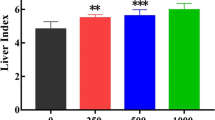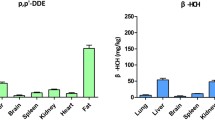Abstract
Trichloroethylene (TCE) hepatotoxicity is controversial. The present study was designed to investigate the mechanism of TCE hepatotoxicity. The toxicity of equimolar concentrations (5.7 mM) of TCE and its two major metabolites, trichloro-acetic acid (TCA) and trichloroethanol (TCL), was determined. TCE cell viability was dose- and time-dependent. Enzyme leakage correlated with decrease in cell viability; significantly increased leakage started at 1.9 mM treatment. 5.7 mM TCA or TCL was not toxic compared with the same dose of TCE. Hepatocytes isolated from phenobarbital pretreated rats exhibited no significant alteration in toxicity parameters when exposed to 1.9 and 5.7 mM concentrations of TCE. While the phenobarbital pretreatment increased the rate of metabolism of TCE. The present study suggests that TCE toxicity occurs before the formation of TCA and TCL.
Similar content being viewed by others
References
Allemand H, Passayre D, Descatoire V, Degott C, Feldman G and Benhamou JP (1978) Metabolic activation of trichloro-ethylene into a chemically reactive metabolite toxic to the liver. J Pharmacol Exptl Therap 204:714–723
Banerjee S, Van Duuren BL (1978) Covalent binding of the carcinogen trichloroethylene to hepatic microsomal protein and to exogenous DNAin vitro. Cancer Res 38:776–80
Baur H, Kasperek S, Pfaff E (1985) Criteria of viability of isolated liver cells. Hoppe-Seyler's Z Physiol Chem 356:827
Berg K, Aune T (1987) Freshly prepared rat hepatocytes used in screening of the toxicity of blue-green algal blooms. J Toxicol Environ Health 20:187–197
Bergmeyer H-U, Bernt E, Hess B (1963) Lactate dehydrogenase in methods of enzymatic analysis. Hans-Utrich Bergmeyer (ed) Academic Press. New York
Cluet JL, Boisset M, Boudene C (1986) Effect of pretreatment with cimetidine or phenobarbital on lipoperoxidation in carbon tetrachloride and trichloroethytene-dosed rats. Toxicology 39:91–102
Farghali H, Machkova Z, Kamenikova L, Janku I, Masek, K (1984) The protection from hepatotoxicity of some compounds by the synthetic immunomodulator muramyl dipeptide (MDP) in rat hepatocytes andin vivo. Meth and Find Exptl Clin Pharmacol 6:449–454
Fuller BB (1976) Air Pollution Assessment of Trichloroethylene, MTR 7142, Research Triangle Park, NC, US Environmental Protection Agency, Contract #68-02-1495. Available from Springfield, VA, National Technical Information Service, No. PB 256-730
Green T, Prout MS (1985) Species differences in response to tri-chloroethylene. II Biotransformation in rats and mice. Toxicol Appl Pharmacol 79:401–411
IARC (1979) Trichloroethylene. Monographs on the evaluation of carcinogenic risk of chemicals to humans. Vol 20, pp 545–572
Kachmar JF, (1970) Enzymes in Fundamentals of Clinical Chemistry. Tietz NW (ed) WB Saunders, Philadelphia, PA, pp 441–449
Lloyd JW, Moore RM, Jr, Breslin P (1975) Background information on trichloroethylene. J Occup Med 17:603–605
Miller RE, Guengrich FP (1982) Oxidation of trichloroethylene by liver microsomal cytochrome p-450. Evidence of chlorine migration in a transition status not involving trichloroethylene oxide. Biochemistry 21:1090–1097
— (1983) Metabolism of trichloroethylene in isolated hepatocytes. Microsomes and reconstituted enzyme systems containing cytochrome. Cancer Res 43:1145–1152
Moldeus P, Hogberg J, Orrenius S (1978) Isolation and use of liver cells. In: Fleisher S, Packer L (eds) Methods in Enzymology. Academic Press, New York, pp 60–71
Pessayre D, Cobert B, Descatoire V, Degot C, Babany G, Funk-Bertano C, Delaforge M, Larrey D (1982) Hepatoxicity of trichloroethylene carbon tetrachloride mixtures in rats. A possible consequence of the potentiation by trichloroethylene of carbon tetrachloride-induced lipid peroxidation and liver lesions. Gastroenterology 83:761–772
Prout MS, Provan WM, Green T (1985) Species differences in response to trichloroethylene. I Pharmacokinetics in rats and mice. Toxicol Appl Pharmacol 79:389–400
Reynolds ES, Moslen MT (1977) Damage to hepatic cellular membranes by chlorinated olfins with emphasis on synergism and antagonism. Environ Health Perspect 21:137–147
Rouisse L, Chakrabarti SK (1986) Dose-dependent metabolism of trichloroethylene and its relevance to hepatotoxicity in rats. Environ Res 40:450–458
Seglen PO (1976) Preparation of isolated rat liver cells. In: Prescott, DM (ed) Methods in cell biology, Academic Press, New York, pp 29–83
Spencer PS, Schaumurg HH (1985) Organic solvent neurotoxicity. Facts and research needs. Scand I Work Environ Health 1:53–60
Story DL, Gee SJ, Tyson CA (1983) Response of isolated hepatocytes to organic and inorganic cytotoxins. J Toxicol Environ Health 11:483–501
Zar JH (1984) Biostatistical Analysis. 2nd ed. Prentice-Hall, Englewood Cliffs, NJ, pp 196–198
Author information
Authors and Affiliations
Rights and permissions
About this article
Cite this article
Kadry, A.M., Farghali, H. & Abdel-Rahman, M.S. Toxicity and metabolism of trichloroethylene in rat hepatocytes. Arch. Environ. Contam. Toxicol. 18, 888–894 (1989). https://doi.org/10.1007/BF01160305
Received:
Revised:
Issue Date:
DOI: https://doi.org/10.1007/BF01160305




